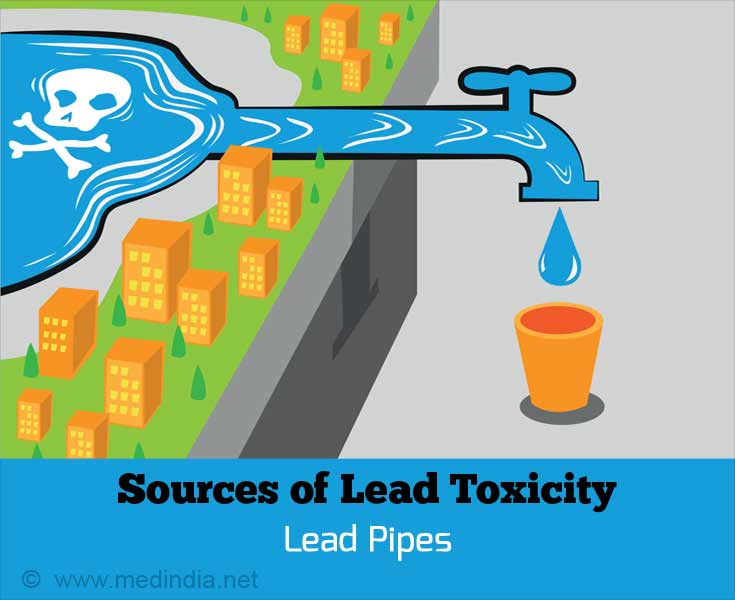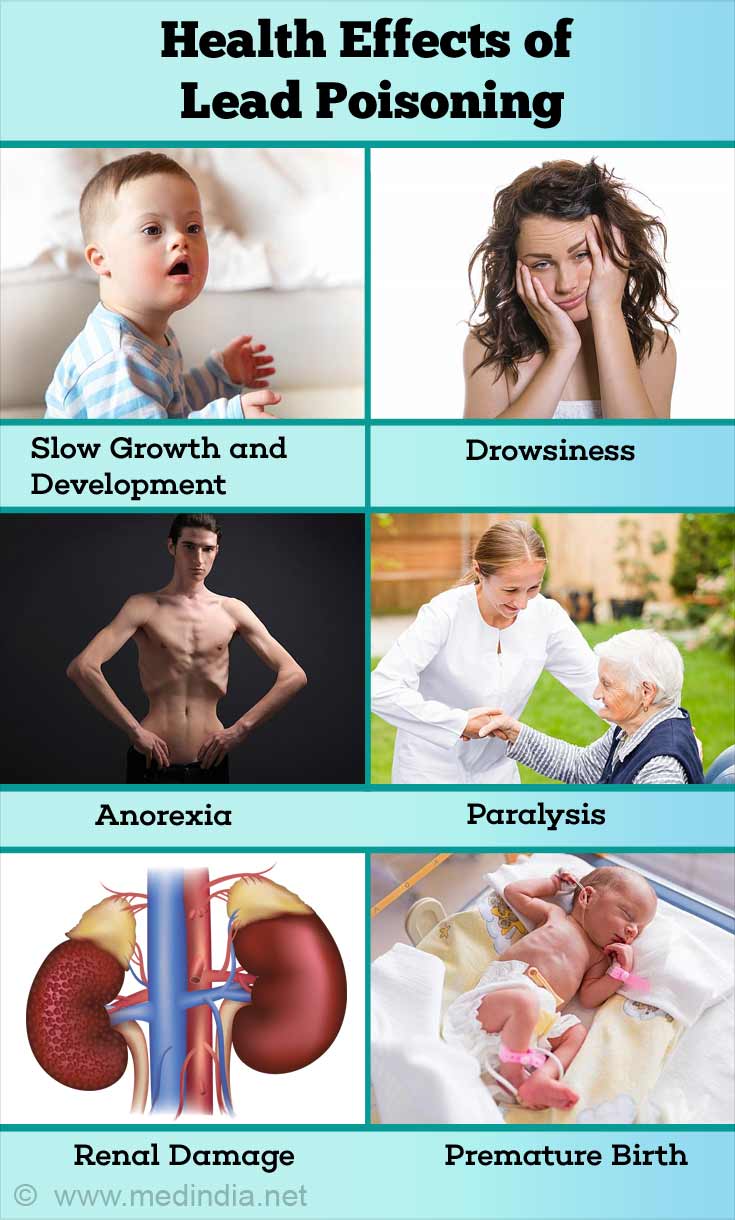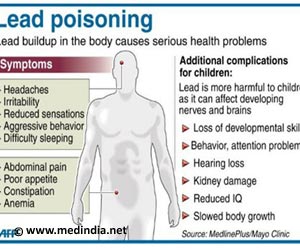- L.J. Fewtrell, A. Pruss-Ustun, P. Landrigan, and J.L. Ayuso-Mateos. Estimating the global burden of disease of mild mental retardation and cardiovascular diseases from environmental lead exposure Environmental Research 94 (2004) 120-133
- Gordon, J. N., Taylor, A., & Bennett, P. N. (2002). Lead poisoning: case studies. British Journal of Clinical Pharmacology, 53(5), 451-458
- Jones, A. (2009). Emerging aspects of assessing lead poisoning in childhood. Emerging Health Threats Journal, 2
- Lead Poisoning - (https://en.wikipedia.org/wiki/lead_poisoning)
- Childhood Lead Poisoning - (http://www.who.int/ceh/publications/leadguidance.pdf)
- Childhood Lead Poisoning Data, Statistics, and Surveillance - (https://www.cdc.gov/nceh/lead/data/)
What is Lead Poisoning?
Lead poisoning occurs when a person is exposed to high levels of the heavy metal lead. Exposure is typically associated with severe health effects.
It is not possible to predict the exact amount of lead, below which there will be no harmful effects on the body. In other words, toxic effects of lead can be seen at low levels in some people or at high levels in others.

Hence there is no known safe exposure level.
Symptoms and conditions vary according to the intensity and duration of exposure and the age of the person. Acute health effects of lead are seen when exposed to a high concentration in a short period of time. Chronic health effects of lead are seen when exposed to repeat low-level doses over a prolonged period.
The main source of lead is in the form of Lead Sulfide in the earth’s crust. While in existence for years, it has been released into the environment through human activities. Through atmospheric transport, it has reached even the remotest locations in the world.
Lead is a cumulative toxicant; in other words, the health effects become more pronounced as the amount of lead in the body increases. It affects the neurological, hematological, gastrointestinal, cardiovascular, reproductive and renal system. It has a neurotoxic effect on children; if the damage goes beyond a repairable extent in children it is irreversible.
The routes of exposure of lead in children are through soil, air, water, food and consumer products. Adults are usually exposed to lead in their occupation. There are over 3 million people in the US whose occupation involves exposure to lead.
Elimination of lead in paint, plumbing, gasoline and solder are the steps followed by the government so far to curb the spread of lead poisoning.
Facts and Statistics of Lead Poisoning
- In 2004, there were 143,000 deaths due to lead poisoning and the global burden of the disease (accounted mainly by developing countries) was 0.6 %. The global burden is calculated in terms of disability adjusted life years and takes into account mild mental retardation and cardiovascular symptoms due to lead exposure.
- According to the Institute for Health Metrics and Evaluation (IHME) there were 853,000 deaths in 2013 due to long-term effects of lead exposure on health. This clearly shows the increase in the number of deaths due to lead poisoning.
- The highest burden of lead exposure (99%) occurs in low and middle-income countries.
- The Center for Drug Control (CDC) has set the reference level for blood lead levels in children as 5 micrograms per deciliter (µg/dL) (micrograms per deciliter) and 10 µg/dL in adults. CDC triggers public health actions beyond these reference levels.
- Public health goals to be achieved by 2020 are eliminating blood lead levels ≥ 10 µg/dL and differences in average risk based on race and social class.
Facts and Statistics of Lead Poisoning in Children
- Lead exposure is responsible for intellectual disabilities caused in 600,000 children every year.
- Lead is passed on from a mother to the child even when the child is in her womb. This results in lower intelligence quotient (IQ) and other behavioral and developmental effects in the newborn.
- Infants and toddlers absorb 4-5 times as much ingested lead as adults from a given source. Their hand-to-mouth behavior makes them vulnerable to lead poisoning from contaminated soil or dust.
- Each increase of 10 µg/dL of lead in children lowers their IQ by an estimated 4-7 points.
- Children living in 4 million households in the US are exposed to high lead levels.
- In the US alone, approximately 500,000 children under the age of 5 have blood lead levels of at least 5 micrograms per deciliter (µg/dL).
Who is at Risk of getting Lead Poisoning or having High Blood Lead Levels?
- Children (especially those below 5) as compared to adults. Children playing with toys containing lead paint are more vulnerable.

- People in developing countries where leaded petrol and pesticides are still used.
- Impoverished, city-dwelling people and immigrants who tend to live in low income, poor areas in developed countries.
- People exposed while working in lead related industries.
- People who consume alcohol.
- People who smoke, as tobacco leaves might be mixed with lead-containing pesticides.
- Adults with calcium and iron deficiencies, and defects in organs that lead tends to affect.
What are the Sources of Lead Toxicity?
Natural activities that release or spread lead include:
- Volcanic activity
- Geochemical weathering
- Sea spray emissions
- Diffusion of lead through soil, sediment and water from mining areas and smelters
Industrial Processes:
- Processes of mining, smelting and refining and recycling of lead
- Occupational exposure during application and removal of protective lead-containing paints
- Production of lead-acid batteries, plumbing material and alloys
- Manufacturing of antiknock and lubricating agents in petrol
- Old industrial hot spots that continue to be contaminated
- Release of leaded petrol into the atmosphere.
- Leaded glass manufacture in informal and cottage-based industries
Food and Smoking:
- Smoking increases lead intake.
- Food grown in soil near mines and smelters
- Foods stored in lead-soldered tins and beverage cans
- Added lead in spices like turmeric
- Leaching of lead into food eaten out of lead-glazed ceramic or pottery dinnerware
Drinking Water:
Household plumbing systems that contain lead pipes, solders and fittings are the main source of lead in tap water. Lead concentration in water depends on the duration of contact with lead and the acidic nature of water.
Hence it is recommended to flush taps in the morning before use.

Domestic Sources:
- Children ingest the contaminated dust from the weathering, peeling or chipping of paints
- People who work in industries that use lead can bring it home
- Lead is present in the body and the paints of toys
- Lead is present in kohl or kajal that is used to decorate the eyes in Asian and African cultures.
What are the Health Effects of Lead Poisoning?
Children are 4-5 times more susceptible to lead poisoning than most adults except for pregnant women.
Effects in children are more pronounced because:
- Intake of lead per unit body weight is higher.
- Neurological effects like slow growth and development, learning and behavioral problems (lowered IQ, Attention Deficit Disorder (ADD), juvenile delinquency and aggression), hearing and speech problems are more pronounced even at low concentrations as their nervous system is still developing.
- Ingestion of household dust.
- Absorption into Gastrointestinal tract quicker.
- Blood brain barrier not fully developed.
In pregnant women, exposure to lead can cause miscarriage, still birth, premature birth and low birth weight and minor malformations in the child.
Acute effects of lead occur due to intense or high exposure in short durations.
- GI disturbances like mild anorexia, nausea, vomiting and mild to moderate abdominal pain.
- Hepatic and severe renal damage.
- Hypertension.
- Neurological effects like malaise, drowsiness and encephalopathy that can lead to severe effects like convulsions and coma and finally death.
Chronic effects of lead occur due to repeat low-level exposure over a prolonged period.
- Hematological effects like anemia.
- Neurological disturbances like headache, irritability, mild lethargy, convulsions, muscle weakness, ataxia tremors and paralysis.
- Cancer in case of occupational exposure.
- Decreased sperm count and increased number of abnormal sperm in men.

How do you Diagnose Lead Toxicity in the Body?
- Acute effects of lead are measured by testing a person’s blood lead level (BLL). When exposed to lead, blood contains 2% of the total body burden of lead.
- 98% of the total body burden of lead goes into an intermediate pool of skin and muscle. From this it goes to a permanent pool of dentine and skeleton at which point it is 95 % of the total body burden of lead.
- The half-life (t ½) of lead in blood is 35 days. In other words, the time taken for lead to become half its concentration in the blood is 35 days. Hence the BLL is used to test exposure from a recent event. – when using an abbreviation, elongate it the first time and give the abbreviated form within brackets. Subsequent repetitions, you may use the abbreviation alone.
- The (t ½) of lead in teeth and bones is 20 – 30 years. Hence chronic cumulative exposure of lead is measured in teeth and bones.
- Physical examination of the person will reveal lead lines in the teeth and hypertension.
- The laboratory tests will show elevated BLL and anemia.
- Acute poisoning will be reflected by elevated transaminase levels and presence of abnormal quantities of protein and glucose in the urine.
- Radiology will reveal lead lines in the growth plate of long bones, especially in children who have suffered chronic exposure.
What is the Treatment of Lead Poisoning?
1. Removal of Lead from the Body
- Lead present in the gastrointestinal tract (as viewed on an X-ray) is removed by whole bowel irrigation, cathartics, endoscopy or by surgically removing it.
- Lead bullets and shrapnel are removed surgically.
2. Symptomatic Treatment
In case of lead encephalopathy, anticonvulsants are used to treat the seizures and corticosteroids and mannitol are used to control the swelling of the brain.
3. Chelation therapy for people with high blood lead levels or symptoms of lead poisoning.
- Used in cases of acute lead poisoning and encephalopathy and for people with blood lead levels > 25 μg / dL.
- The chelating agent containing 2 negative charges binds with metal ions like lead containing multiple positive charges. The resulting chelate is non-toxic and can be excreted by urine.
- Examples of chelating agents used in lead poison treatment are edetate disodium calcium (CaNa2EDTA) and dimercapto propanol or British antilewisite (BAL) (injected), dimercaptosuccinic acid and d-pencillamine (given orally).
- Disodium EDTA should not be used in children, as it may lead to dangerously low calcium levels (hypocalcemia), and death.
- Chelation therapy is not so useful in people who are asymptomatic with high blood lead levels and in people who are chronically exposed to low levels of lead.
- One limitation is the recurrence of high blood lead levels after chelation therapy has been stopped due to the leached lead from the bones into the blood. Repeat therapies are then needed.

How do we Reduce Lead Exposure?
Eliminating source level exposure by removing lead in:
- Additives in motor fuels
- Paints
- Solder in food / drink cans
- Plumbing and fittings of drinking water pipes
- Homes, schools, school materials and toys
- Glazed pottery
- Traditional medicines and cosmetics
Prevention of exposure:
- Children should keep away from electrical and electronic waste like lead-acid batteries and computers.
- Lead-containing waste recycling should be conducted under appropriate industrial hygienic measures.
- Humans should keep away from contaminated sites.
Monitoring:
- Blood levels of adults during occupational exposure
- Blood levels in children and pregnant women by sensitive analytic methods
- Foods that have high lead content
Mass Education:
Awareness needs to be created about products containing lead and preventive measures to keep their young ones safe.
What is the Prognosis of Lead Poisoning?
The extent and the duration of lead exposure mainly control the outcome. While symptoms of the heart and kidney are reversible, effects on the Central Nervous System are irreversible.
In case of a cerebral involvement, the mortality rates is 25 %.
Lead encephalopathy causes permanent brain damage in 70-80 % of children even after getting the best treatment.
Among children who develop the symptoms of encephalopathy before chelation therapy, 40 % of them are likely to develop cerebral palsy.







